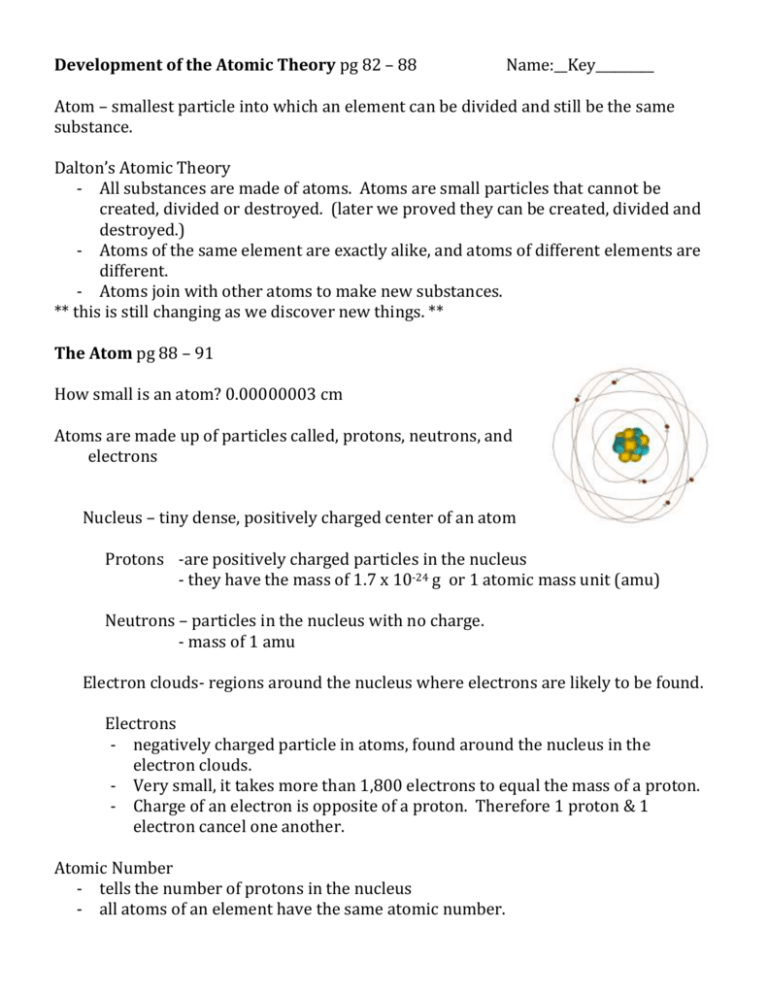The Atom
advertisement

Development of the Atomic Theory pg 82 – 88 Name:__Key_________ Atom – smallest particle into which an element can be divided and still be the same substance. Dalton’s Atomic Theory - All substances are made of atoms. Atoms are small particles that cannot be created, divided or destroyed. (later we proved they can be created, divided and destroyed.) - Atoms of the same element are exactly alike, and atoms of different elements are different. - Atoms join with other atoms to make new substances. ** this is still changing as we discover new things. ** The Atom pg 88 – 91 How small is an atom? 0.00000003 cm Atoms are made up of particles called, protons, neutrons, and electrons Nucleus – tiny dense, positively charged center of an atom Protons -are positively charged particles in the nucleus - they have the mass of 1.7 x 10-24 g or 1 atomic mass unit (amu) Neutrons – particles in the nucleus with no charge. - mass of 1 amu Electron clouds- regions around the nucleus where electrons are likely to be found. Electrons - negatively charged particle in atoms, found around the nucleus in the electron clouds. - Very small, it takes more than 1,800 electrons to equal the mass of a proton. - Charge of an electron is opposite of a proton. Therefore 1 proton & 1 electron cancel one another. Atomic Number - tells the number of protons in the nucleus - all atoms of an element have the same atomic number. Atomic Mass (pg. 93) - mass of an atom expressed in atomic mass units (see above) - tells you the number of protons and neutrons in nucleus of the atom How to read a Periodic table of elements Atomic number amount of protons 79 Name Au Gold 197.0 Symbol Atomic mass - average mass of atom - tells how many protons and neutrons Development of the Atomic Theory pg 82 – 88 Name:________________________ Atom – Dalton’s Atomic Theory - ______________________________________________________________________________________. Atoms are small particles that cannot be created, divided or destroyed. (later we proved they can be created, divided and destroyed.) - ______________________________________________________________________________________, and atoms of different elements are different. - ____________________________________________________________________________________________. ** this is still changing as we discover new things. ** The Atom pg 88 – 91 How small is an atom? _______________________________ cm Atoms are made up of particles called, _______________________, __________________________, and __________________________. Nucleus – ____________________________________________ of an atom Protons -are ___________________________________________in the nucleus - they have the mass of 1.7 x 10-24 g or 1 atomic mass unit (________) Neutrons – _____________________ in the nucleus with ____________________________. - mass of 1 amu __________________- regions around the nucleus where electrons are likely to be found. Electrons - ______________________________________________ in atoms, found around the nucleus in the electron clouds. Electrons continued - ______________________, it takes more than 1,800 electrons to equal the mass of a proton. - ________________________________ of an electron is opposite of a proton. Therefore ______________________ & _______________________ cancel one another. Atomic Number - tells the number of __________________________ in the nucleus number of protons in an atom tell you which ____________________ it is. - all atoms of an element have the same atomic number. Atomic Mass (pg. 93) - mass of an atom expressed in atomic mass units. - tells you the number of _________________________ and _______________________ in the nucleus of the atom. How to the elemental squares on a periodic table. (page 108) 79 Au Gold 197.0








